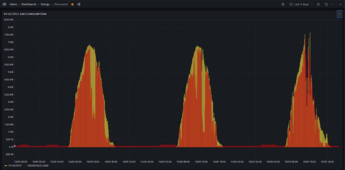meetyg
Solar Addict
- Joined
- Jun 4, 2021
- Messages
- 1,243
A bit theoretical, but has practical implications:
What's more energy efficient: Pushing PV power to the grid, or storing in battery and using it ?
Let's say our PV array produces 5kwh a day. For the sake of the discussion let's also assume that we are on a fixed grid tariff, and grid-tie is also 1:1 usage/payment ratio per kwh consumed/produced.
Now we all know that there are conversion losses in the way, whatever method we choose (grid-tied or off-grid with battery storage). My question is which one will save the most money on the monthly grid bill?
Let's get a bit technical:
Grid-tied: PV is DC, and this needs to be converted to AC. I suppose that this DC power is either stepped up to a higher DC voltage, or stepped down to a lower DC voltage, before being inverted to AC. Whether it's being stepped up or down, is probably related to PV voltage, the equipment being used and the grid system voltage (110v US or 220v European, for example).
Either way, we have some losses during this step-up or step-down phase. Are there more conversion stages in the way?
So our 5kwh PV in DC, might translate to say 80-90% AC output, being fed back to the grid.
Off-grid:
PV is DC and battery is DC. I'm assuming PV voltage is always stepped down because common battery voltages (12/24/48v) are usually under the PV voltages commonly used. But I know off-grid inverters often have an internal high-voltage DC bus. Is the PV voltage stepped up to this HV DC bus and then stepped down to the battery voltage?
Again, either way we have losses here too.
But there's more: After storing this PV power in the battery, we have more inefficiencies in the way:
1. Battery efficiency (how much power is put into battery vs. how much you can actually pull from it). Lifepo4 is probably somewhere around 90% efficient. Lead acid probably less. Let's assume Lifepo4.
2. Converting DC from the battery back to AC, for powering loads (inverting).
Intuitively, it seems that are more conversion steps with battery storage vs. grid-tied.
But am I correct?
If so, how much are we loosing here compared to grid-tied?
I'd like to hear your thoughts. Has anyone actually calculated or measured the end-to-end efficiency of thier grid-tied/off-grid system?
Thanks.
What's more energy efficient: Pushing PV power to the grid, or storing in battery and using it ?
Let's say our PV array produces 5kwh a day. For the sake of the discussion let's also assume that we are on a fixed grid tariff, and grid-tie is also 1:1 usage/payment ratio per kwh consumed/produced.
Now we all know that there are conversion losses in the way, whatever method we choose (grid-tied or off-grid with battery storage). My question is which one will save the most money on the monthly grid bill?
Let's get a bit technical:
Grid-tied: PV is DC, and this needs to be converted to AC. I suppose that this DC power is either stepped up to a higher DC voltage, or stepped down to a lower DC voltage, before being inverted to AC. Whether it's being stepped up or down, is probably related to PV voltage, the equipment being used and the grid system voltage (110v US or 220v European, for example).
Either way, we have some losses during this step-up or step-down phase. Are there more conversion stages in the way?
So our 5kwh PV in DC, might translate to say 80-90% AC output, being fed back to the grid.
Off-grid:
PV is DC and battery is DC. I'm assuming PV voltage is always stepped down because common battery voltages (12/24/48v) are usually under the PV voltages commonly used. But I know off-grid inverters often have an internal high-voltage DC bus. Is the PV voltage stepped up to this HV DC bus and then stepped down to the battery voltage?
Again, either way we have losses here too.
But there's more: After storing this PV power in the battery, we have more inefficiencies in the way:
1. Battery efficiency (how much power is put into battery vs. how much you can actually pull from it). Lifepo4 is probably somewhere around 90% efficient. Lead acid probably less. Let's assume Lifepo4.
2. Converting DC from the battery back to AC, for powering loads (inverting).
Intuitively, it seems that are more conversion steps with battery storage vs. grid-tied.
But am I correct?
If so, how much are we loosing here compared to grid-tied?
I'd like to hear your thoughts. Has anyone actually calculated or measured the end-to-end efficiency of thier grid-tied/off-grid system?
Thanks.



